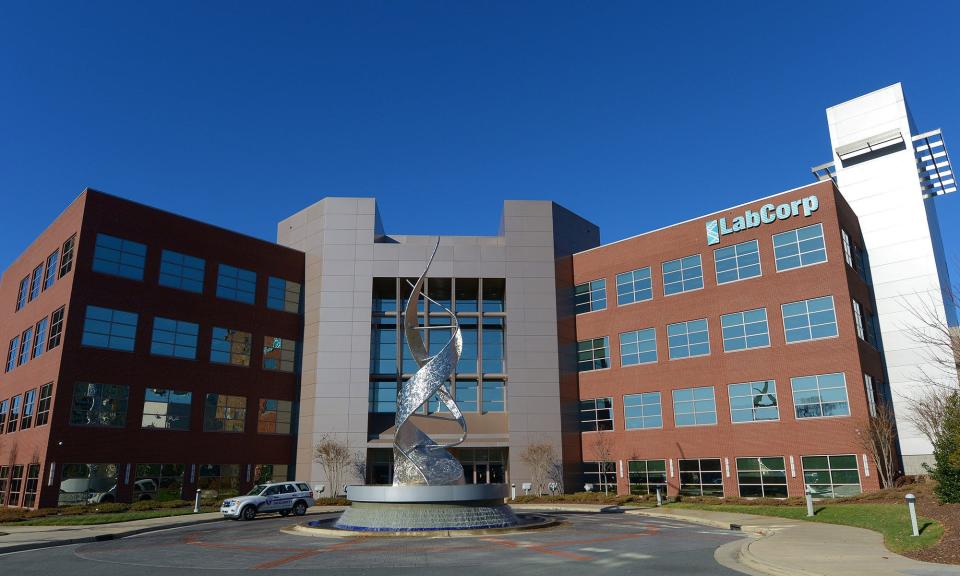Private lab data before COVID: Quest and Labcorp are warring rivals in a testing duopoly
Mark Brown witnessed the birth of modern diagnostic testing from the back seat of his mother's station wagon. He just doesn't remember it, because he was a newborn himself. Mark’s father, Paul Brown, was 29 in 1967 when he founded Metropolitan Pathology Laboratory by borrowing $500 to rent an apartment in upper Manhattan.
The operation’s logistics were straightforward. Paul Brown’s wife, Cynthia, packed their eldest son, Richard, 3, and Mark, the infant, into the family station wagon. She drove a few blocks to Columbia Presbyterian Hospital to pick up Pap smear slides. Then she drove back to the apartment, where her husband stained the slides by hand in the bathtub.

“I do remember double-parking at the hospital,” Cynthia Brown said by email.
Brown and Dr. James Powell were residents together at Englewood Hospital in New Jersey, where they worked with one of the first commercially available automated testing machines. Brown integrated such machines into his company, later renamed MetPath, which became Quest Diagnostics.
Powell returned to his hometown of Burlington, North Carolina, to create Biomedical Laboratories, which used similar technology. After a series of mergers and acquisitions, Powell’s company became Labcorp.
Both companies — called the "blood brothers" within the testing industry — grew aggressively, simultaneously and by similar means. Automated lab machines were expensive, and required vast quantities of samples to operate profitably. Using these greater economies of scale, both companies lured testing contracts away from traditional, smaller labs by promising doctors and hospitals faster, cheaper tests.
Some small labs went out of business. Others became targets for acquisition. In time, Labcorp and Quest hunted bigger game.
Quest purchased SmithKline Beecham Clinical Laboratories in 1999 for $1.3 billion. It followed with deals in 2002, 2003 and 2005, in which Quest paid $2.2 billion for three major competitors.
Labcorp paid $480 million to acquire Dynacare in 2002. It paid $925 million in cash for Genzyme in 2010, followed by a deal in 2014 to acquire Covance for $6.1 billion.
Competitors came to view Labcorp and Quest as more focused on mergers and acquisitions than they were on running laboratories.
“They’re not lab companies,” said Richard Faherty, a former laboratory executive who served as chief information officer for BioReference Laboratories. “They’re M&A companies in the lab space.”
Labcorp, Quest Diagnostics and their trade association, the American Clinical Laboratory Association, did not respond to requests for comment for this story. In a recent blog post, the association said its members “deliver screening and diagnostic test results that serve as the foundation for early diagnosis, disease prevention, and personalized care for millions of patients each day.”
Today, independent labs that operate outside of hospitals have three options, said David Flack, owner of Pathology Associates of North Texas, a small lab in Wichita Falls.

They can find a low-profit niche that Quest and LabCorp care little about – maybe performing allergy tests, or operating in places like Nebraska, where low population densities can’t support Quest and Labcorp’s expensive logistics networks.
They can agree to be purchased.
Or small labs can risk direct competition with Quest or Labcorp, which have massive economies of scale, cheaper tests, and armies of salespeople dedicated to winning contracts with hospitals.
“It’s a duopoly,” Flack said. “As the duopoly cannibalizes more places like us, you have fewer places to do the work. We’re a flea on an elephant.”
“Quest and Labcorp monopolize through financial arrangements,” said Jay Weiss, president of Allermetrix, an allergy testing lab outside Nashville. “Their ability to acquire laboratories, to work in exclusive arrangements state by state, allows them to inch out other competitors.”
After Quest and Labcorp had purchased most rival laboratories, they started to pursue monopoly contracts with insurers. Labcorp signed a $3 billion, 10-year contract in 2006 with UnitedHealthcare, becoming the insurance giant’s exclusive provider of diagnostic tests for 11.1 million people. Quest Diagnostics, not to be outdone, scored access to test all 16 million people insured by Aetna in March 2007.
Next the testing giants pursued similar contracts with big hospital companies. Quest took over inpatient testing for all seven hospitals owned by Barnabas Health in New Jersey in December 2015, and a similar deal six months later with HealthONE hospitals in Denver.
In the health care industry, this is called “narrow networking.” The practice locked in the duopoly’s advantages, while locking their smaller rivals out.

“The biggest problem is the large national laboratories compete not on quality and service; frequently they compete with contracts that eliminate the competition,” said Mark Birenbaum, executive director of the National Independent Laboratory Association. “It means that eventually with time, other labs are forced out of business, forced to merge or sell because they can’t get in-network with major insurance carriers to get business. It means the big labs continue to grow in volume and strength.”
Labcorp, Quest Diagnostics and the American Clinical Laboratory Association, the trade organization that represents the nation’s largest labs, did not respond to requests for comment on narrow networks.
In recent years, narrow networks became slightly less narrow. On Jan. 1, 2019, UnitedHealth Group opened up its contract, keeping close ties with Labcorp but allowing Quest Diagnostics to be considered in-network for the company’s expanded population of 48 million enrollees.
On the same day, Quest lost exclusive access to 20 million insurance customers when Aetna allowed Labcorp into the network.
By then, few direct competitors to Quest and Labcorp remained. The duopoly possessed vast data, logistics and laboratory systems, capable of processing massive volumes of patient samples quickly and efficiently.
Under stress, however, these systems grow brittle. That’s partly because the era of narrow-network lab contracts happened to coincide with the biggest change in medical records since the invention of the ballpoint pen.
Medical records technology: Broken in a colossal way
In his professional life as founder of one of the world’s first automated diagnostic laboratories, Paul Brown embraced computers. In his personal life, Brown didn’t see the point. Whenever his sons sent him an email, Brown invited his secretary into his office. He would dictate a response. Then the secretary would return to her desk, type her notes into an email, and send it.
“He and I would laugh about it,” Brown said. “He would say, ‘I respond to all of your emails. I just do it through transcription.’”
Mark followed in his father’s footsteps. Both attended Harvard University. Both built careers merging medicine and technology. Mark became an ocular-facial surgeon, a rarified specialty that depends on the latest computers and plastics. He also started his own company, called EyePlastics.com, which offers patient referrals to other doctors in the field. He wrote the software himself.

Growing up in a family that helped invent modern health care data systems, Brown gets angry when those systems fail. Every day he deals with hospital electronic records systems, which he describes as slow and counterintuitive.
“It’s a lot of drop-downs. It’s very hard to enter free text. It’s impossible to do diagrams,” said Brown, whose practice is located in Mobile, Alabama. “They’re just not meant for humans.”
When a patient transfers from one hospital to another, electronic health records should make it easy for her medical data to travel with her. But it’s never easy, Brown said. The problem, experts agree, is that hospital data systems often can’t talk to each other. This creates special problems for a surgeon like Brown, who has operating privileges at all four hospital chains in Mobile.
Every time a patient transfers to a different hospital, Brown must dig deep into the first hospital’s computer system, download the patient’s medical file, send it to himself in an email, and hope he doesn’t accidentally miss anything.
“It’s broken in a colossal way. There is no sharing of information among providers or labs,” Brown said. “I know what computers are capable of. And it’s just we, the United States, have failed.”
Go digital? Not so fast.
As recently as 2009, most American health care happened on paper, said A. Jay Holmgren, assistant professor of health care informatics at University of California, San Francisco. That changed when President Barack Obama signed the 2009 HITECH Act, intended to bring doctors and hospitals into the modern era. Under the law, Congress eventually allocated $35 billion, primarily to subsidize the implementation of Electronic Health Record, or EHR, systems. Of that motherlode, Holmgren said, little was dedicated to digitizing public health.
Most went to private hospitals and doctor’s offices. The market for digitized health records already was dominated by its own pair of powerful companies, Epic and Cerner, which deliver reams of customer data to physicians using complex user interfaces that are not intuitive, Holmgren said.
Picture an old desktop IBM running do-it-yourself tax software for Windows 95.
“It’s pretty ugly,” Holmgren said.
Cerner did not respond to requests for comment for this story. Leslie Selby, a sales executive at Epic, said the company employs teams of developers to constantly improve the user experience.
“The goal is to make the system a joy to use,” Selby said.
Today, electronic health record systems by Epic and Cerner function as the central nervous system for every decision made by hospital staff. From a single capsule of Tylenol, to complete health records for millions of people, everything is tracked by the hospital’s digital system. As they grew to perform so many complex tasks, medical records systems also became rigid. Surgeons like Brown no longer could draw diagrams of the body by hand, making the process of adding notes to a patient’s medical file slower and more cumbersome.
And every time a doctor orders a procedure, from a surgery to a COVID test, she is forced to use the drop-down menu built into her computer’s user interface. If her hospital has signed an exclusive testing contract with one of the major testing companies, then either “Labcorp” or “Quest” will appear, Holmgren said.
This is called “welded-in.” During normal times, it can make ordering tests simpler and faster than scribbling out orders by hand. It also locks in the duopoly’s advantage. Due to agreements that Cerner and Epic forge with hospital administrators, doctors find it impossible to shop for labs that might offer higher-quality service, more reliable tests, or faster turnaround times.

“Physicians are really busy, and they get paid by the volume of patients they see. It’s not in their best interest to spend a lot of time digging through menus,” Holmgren said. “Then we make it difficult to do anything but the default, so these things get welded in. You really can’t go outside of whatever lab options the system gives you.”
Another problem common to digital health records, experts said, is their complexity can make the data unreliable. Every hospital runs a stack of software programs. Each program may arrange its fields of data in a unique format. Every time a program passes data up and down the stack becomes an opportunity for the data to change, or to drop out entirely, said Thomas Durant, an informatics researcher at Yale School of Medicine. When a hospital sends data to a software stack operated by a competing hospital or an outside laboratory, the complexity multiplies, as does the likelihood that data will go missing.
“You have billions of opportunities for error,” said Dr. David Black, a pharmacology professor at Vanderbilt University and founder of Aegis Sciences, a diagnostic laboratory company. “It’s so complex that when errors are made, they’re typically not one-offs. It’s easy to have hundreds of errors bundled together because they handle such tremendous volumes.”
When doctors receive test results with strange or missing data, they order another test, Durant said. During normal times, this isn’t a problem.
But when the only laboratory in a hospital’s computer system is already overwhelmed by a COVID surge, the combination of welded-in lab providers plus unreliable data makes the entire system fragile, and prone to bottleneck.
“Every data element has to persist through all these layers [of software] and not get dropped. That’s hard to do,” Durant said. “You can’t always trust that data to mean much. If clinicians don’t trust it, they order another test.”
Frustrated by the cumbersome menus and unreliable systems provided by Epic and Cerner, Mark Brown did something radical: He quit them. At great personal expense, Brown switched his office from Epic and Cerner’s interfaces, which he describes as terrible, to Modernizing Medicine, a small company that offers intuitive screens on iPads.
“It’s as good as it gets in terms of doctor frustration," he said of the change. “It’s not cheap to do that, but I’m all about quality of life.”
This article originally appeared on USA TODAY: Private lab testing before COVID: Dominating suppliers

